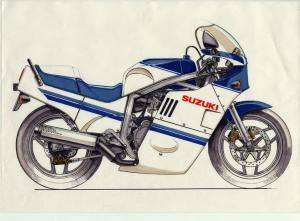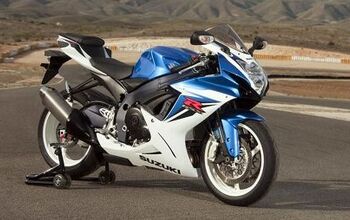Suzuki GSX-R History - Motorcycle.com
Twenty-eight years ago, in 1985, the Suzuki GSX-R entered the world and changed the motorcycle landscape as we know it. In 2012, Suzuki celebrated the one-millionth GSX-R to roll off the assembly line with a limited run of special edition GSX-R1000s. Fittingly, only 1,985 will be produced worldwide.
To honor the momentous occasion, Motorcycle.com is taking a look back at nearly three decades of GSX-R, highlighting some important milestones along the way. Thanks largely to the 1985 GSX-R750, originally unveiled in September, 1984, at the Cologne Motorcycle Show, today’s sportbikes are often considered “racebikes with lights.”
1985 GSX-R750
The one that started it all. Before 1985 UJMs (Universal Japanese Motorcycle) ruled the streets, and modified versions of them were what you raced on. The GSX-R750 changed all that. Designed to be a racebike for the road, Suzuki engineered a machine to tackle the World Endurance series (World Superbike didn’t yet exist) and gave it lights and mirrors for street worthiness. The top class of World Endurance had a displacement of 750cc, so Suzuki followed suit.
The Gixxer’s air/oil-cooled inline-Four engine cranked out a purported 100 horsepower, far more than any of its competitors. But most critical to its performance was its revolutionary light weight. At just 394 pounds dry, the GSX-R was as much as 78 pounds lighter than its 750-sized competition. Racing success came quickly, as the new bike finished 1-2 at the 1985 Le Mans 24-hour race and took victory at the grueling Isle of Man TT.
The old adage “race on Sunday, sell on Monday” most definitely applied to the new GSX-R, as it became a sales hit. Launched to world markets in 1985, the GSX-R750 didn’t make it to America until ’86.
1986 GSX-R1100
Developed alongside the 750, the GSX-R1100 was released in 1986 to be the more forgiving, less high-strung, sport-touring GSX-R. Better suited for the road instead of the track, the bigger engine allowed the rider to be lazy with shifts.
However, the 1100 was still developed with racing technology, being the first production motorcycle with a cartridge fork. The GSX-R1100 didn’t see much closed circuit track time, but later in its evolution process it became one of the most popular platforms for motorcycle drag racing.
1988 GSX-R750 “Slingshot”
For 1988 the 750 got its first major overhaul and its first nickname. Suzuki went searching for more power to match its liquid-cooled competition and went to a shorter-stroke 748cc engine, now with a ram-air intake and redesigned carburetors.
One side of the carburetor slide was flat, while the other featured a semi-circular curve Suzuki said “slingshot” the air-fuel mixture to the cylinders. Gimmick or not, the slingshot moniker stuck. Still, the new machine did boast genuine performance improvements.
Fairings were redesigned for less drag, it had the shortest wheelbase in class, its aluminum frame was 60% more rigid, and cooling efficiency was improved dramatically. The modifications worked, despite an increase in weight, as the bike won both the rider and manufacturer championships in the World Endurance series that year.
For 1989, the 1100 received its first full model revamp as well, the biggest difference being an engine jump from 1052cc to 1127cc. The chassis was more rigid, fork stanchions grew to 43mm and 17-inch wheels and tires were fitted for the first time.
1992 GSX-R750
The 90s may be remembered as the decade of awful paint schemes, and examples like this are a reason why. After a successful run with air/oil cooling, the 1992 750 marked a drastic switch to liquid-cooling to help meet the demands of racing. But Suzuki didn’t completely abandon oil-cooling; oil injectors cooled the piston undersides while the oil cooler was itself cooled with liquid.
A new frame and swingarm provided 24% more torsional rigidity compared to the outgoing model, while top speed was a claimed 157 mph. The chassis and engine changes helped, but Suzuki struggled with production racing success for much of the ’90s as the other Japanese brands – and Ducati – made strides.
Interestingly, despite Suzuki claiming otherwise on its website, 1992 was also the year of the first GSX-R600. Really just a 750 with a 599cc engine, it was slow, heavy and an underperformer. Not many examples of these early 600s exist, as they were discontinued after 1993 while Suzuki took the next four years to correctly engineer a 600cc Gixxer.
1996 GSX-R750
The 1996 model year was another defined with a funny acronym. This time: SRAD. Short for Suzuki Ram Air Direct, the latest 750 marked a dramatic turn for Suzuki. It had been nearly a decade since winning a major title and the aging GSX-R was getting long in the tooth.
To fix this, Suzuki borrowed technologies and dimensions from Kevin Schwantz’s 1993 500cc World Championship-winning RGV500. The company finally ditched the double cradle frame and replaced it with the much stiffer aluminum twin-spar frame.
In it was a short stroke (72.0mm x 46.0mm) liquid-cooled, DOHC, four-valve-per-cylinder engine incorporating the aforementioned SRAD design to force air into the airbox for improved top end power. A feature seen on every GSX-R since.
The 750 again took the World Endurance crown in 1997, 1999 and 2000. In AMA competition, 1999 marked the coming of a name we’d hear many times again, as Australian Mat Mladin won his first of seven Superbike titles.
1997 GSX-R600
The third member of the GSX-R family, the GSX-R600, was "officially" introduced in 1997 to compete in Supersport racing worldwide in the popular new displacement category. Essentially a “mini 750,” the 600 was 11 pounds lighter than its bigger brother.
Engine dimensions included a bore and stroke of 65.5mm x 44.5mm, with semi flat-top pistons and 12.0:1 compression ratio. The 600’s bodywork was designed in the wind tunnel for optimum aerodynamics at high speed.
Suzuki didn’t have to wait long for racing success with the 600, as Fabrizio Pirovano won the 1998 World Supersport title and Stephane Chambon repeated the feat a year later. In 1998, Suzuki decided to cease production of the GSX-R1100. While sad news to some, what followed was sure to “own the racetrack.”
2001 GSX-R1000
For 2001, Suzuki completely updated the GSX-R600 with a new frame and engine, the latter incorporating fuel injection for the first time. Meanwhile, Mladin won his third-consecutive AMA Superbike title on the 750. But the big news for 2001 was the introduction of the GSX-R1000.
Despite the larger, 988cc engine and beefed up frame, the 1000 was only nine pounds heavier than its 750 little brother. It featured fuel injection with dual throttle valves, titanium-nitride-coated fork stanchions for minimal stiction, and six-pot brake calipers. Straight away the new 1000 won titles in both the Japanese and World Endurance championships.
Soon, racing regulations would take a dramatic shift, allowing Superbikes displacements of 1000cc and Supersports 600cc, leaving the beloved 750cc machinery virtually obsolete. As such, all other manufacturers ceased production of their middle-displacement sportbikes. Not Suzuki. Committed to keeping tradition alive, the GSX-R750 is still in production.
2005 GSX-R1000
To this day, some credit the 2005 GSX-R1000 as the greatest iteration of the machine to date. In fact, it won our Literbike Shootout that year against a rather competitive field. Winning was something the ’05 1000 did often, as Mladin won his sixth AMA Superbike title on one, the Suzuki Castrol Endurance Racing Team won yet another World Endurance title, and of course, Troy Corser claimed his second World Superbike championship on it nearly a decade after his first.
For 2005 the 1000 again went on a diet, becoming the lightest literbike in the class, according to Suzuki. But as the bike slimmed down, the engine bulked up. Engine displacement grew 11cc from 988cc to 999cc, dual injectors were adopted for high-rpm power, a slipper clutch kept the rear wheel in check and fairings were further redesigned for reduced drag.
The following year, the 600 and 750 received major updates. The engine’s physical dimensions were smaller, meaning it could be placed in an optimum position for ideal weight balance. This also allowed a longer swingarm for stability while maintaining the same wheelbase as before.
Dual injectors and a slipper clutch, technologies both adopted from the 1000, were now carried over. The two bikes also featured adjustable pegs to fit riders of various sizes.
2007 GSX-R1000
Due to ever-tightening emission regulations, the 2007 GSX-R1000 put on a few pounds, mainly from the dual exhaust system and huge under-engine chamber to please the sniff test. However, Suzuki attempted to make up for this weight penalty with more power. The list includes forged aluminum pistons, shot-peened con-rods, hollow camshafts, titanium valves, 12-hole fuel-injectors, iridium spark plugs, and bigger airbox and exhaust ports.
In our 2007 Literbike Shootout, the new Suzuki beat its Japanese competition in the horsepower test at 158.8 hp, three more than its next closest rival.
The ’07 Gixxer 1000, however, would mark the first appearance of electronics entering the GSX-R line with the introduction of selectable power modes. Choose between A, B or C modes at the press of a thumb toggle to have power levels and delivery drop accordingly. Reactions are mixed on its usefulness, but the technology is still seen on all three GSX-Rs today.
2011 GSX-R600
The current line of GSX-R600s and 750s started in 2011, when Suzuki focused on efficiency, weight loss and chassis development. To that end, the engines received better low- and mid-range thanks to reduced mechanical losses and better crankcase ventilation.
After that, the bikes shed nearly 20 pounds and were fitted with a Showa Big Piston Fork and Brembo monobloc calipers, providing excellent suspension damping and braking power. And though it hasn’t seen much racing success, we still consider the 600 one of our favorite bikes in the class.
2012 GSX-R1000
Now we arrive at the present GSX-R1000. Debuting at a time of financial hardship for Suzuki, combined with the emerging presence of European literbikes, the new 1000 may not have the panache or hype its predecessors enjoyed, but it’s still a solid performer.
The crankcase ventilation revisions previously made on the 600 and 750 are now seen on the 1000. Pistons are lighter, compression gets bumped a tick and camshafts give slightly more exhaust lift, all in a quest for more low- and mid-range punch.
Suzuki again put the big Gixxer on a diet. Gone are the twin exhausts and huge under-engine chamber, replaced by a single canister and cleaner plumbing under the engine. Then came Brembo monobloc calipers, providing excellent stopping power. All told, the new GSX-R1000 is 4.4 pounds lighter than its predecessor.
Now we’ve come full circle. Over the years, GSX-Rs have won virtually everything there is to win in road racing multiple times over, both domestically and worldwide. All three engine sizes have been among our favorites at Motorcycle.com, and despite the company facing financial struggles lately, we eagerly anticipate what Suzuki will do next with the GSX-R.
Related Reading
2013 Kawasaki ZX-6R vs. 2012 Suzuki GSX-R750 vs. 2012 Triumph Daytona 675R - Video
2012 Suzuki GSX-R1000 Review - Video
2012 Japanese Superbike Shootout - Video
2011 Suzuki GSX-R600 Review
2009 Supersport Racetrack Shootout
2009 Supersport Shootout
2011 Suzuki GSX-R750 Review
2009 Suzuki GSX-R1000 Review
2008 Suzuki GSX-R600 Review
2007 Suzuki GSX-R750 Review
2004 Suzuki GSX-R600 Review
2003 GSX-R1000: Dis be de one, Huck
Attack Suzuki GSX-R1000
2001 GSX-R1000 Street Ride
First Ride: 2001 Suzuki GSX-R1000
2001 Suzuki GSX-R600
Middleweight Messiah: Riding the GSXR-750
First Ride: 1995 Suzuki GSXR1100
More by Troy Siahaan
























![Suzuki GSX-R History [video]](https://cdn-fastly.motorcycle.com/media/2023/05/07/11554975/suzuki-gsx-r-history-video.jpg?size=350x220)















Comments
Join the conversation